
Charlotte Guichard highlights everything that goes against the Kantian ideal. She is working on an anthropology of the picture by showing that art is also material and has what she calls its own preaesthetic regime. She lays stress on what vision by itself conceals: a whole world of gestures and practices, an entire material and tactile relationship with art. Doing so, she locates two distinct genealogies: an ideal approach and a trivial approach that comes from the studio, the room of the art lover, and an Age of the Enlightenment material philosophy of the subject and of forms of knowledge.
Laurence Bertrand Dorléac
Materiality
and Desire:
A Brief Anthropology of the Picture
In his On the Genealogy of Morality, Friedrich Nietzsche has some fun waxing ironic about Immanuel Kant and his aesthetics. “[I]n that famous definition Kant gives of the beautiful,”
Kant said: “Something is beautiful if it gives pleasure without interest.” Without interest! Compare this definition with another made by a genuine “spectator” and artist—Stendhal, who once called the beautiful une promesse de bonheur. Here, at any rate, the thing that Kant alone accentuates in aesthetic matters: le désintéressement, is rejected and eliminated. Who is right, Kant or Stendhal? — However, as our aestheticians never tire of weighing in on Kant’s side, saying that under the charm of beauty, even naked female statues can be looked at “without interest,” I think we are entitled to laugh a little at their expense: [ref]Quoted in Georges Didi-Huberman, Peuples en larmes, peuples en armes (Paris: Minuit, 2016), p. 62-63. Friedrich Nietzsche, On the Genealogy of Morality, ed. Keith Ansell-Pearson, trans. Carol Diethe (Cambridge: Cambridge University Press, 2006), p. 74.[/ref]
Aesthetics and ascetics could thus be said to go together. The Kantian ideal of beauty and taste could be said to have promoted a disinterestedness that went hand and hand with a repression of touch and a dematerialization of art. One’s relationship with art was thus becoming purely contemplative. Kant’s theoretical coup and his considerable critical reception in nineteenth- and twentieth-century philosophy of art were such that they have rendered us almost incapable of understanding what I will call here the preaesthetic regime of art.[ref]My interpretation is indebted to Jacqueline Lichtenstein’s Les raisons de l’art. Essai sur les théories de la peinture (Paris: Gallimard, 2014); Caroline van Eck, Art, Agency and Living Presence: From the Animated Image to the Excessive Object (Boston: De Gruyter, 2015), p. 131: “Kant’s epistemological barrier against fetishism”: “Kant’s Critique may accordingly be read as a manoeuvre to contain art’s agency. . . . The symbol, or manifestation, of this aesthetic attitude is the museum, where works of art, deprived of their religious status, of their life and death, are exposed to the gaze only of the art lover, and protected by their glass cases from his or her desires and fears.”[/ref] In stressing the visual sense, aesthetics ca. 1800 occulted a whole world of gestures and artistic practices that had, however, fashioned a more material and tactile relationship to art. In 1795, in his Letters Upon the Aesthetic Education of Man, Friedrich von Schiller could thus define the frontiers of humanity in connection with this new aesthetics: “While still a savage, man only enjoys through touch merely . . . As soon as he begins to enjoy through a sight, vision has an independent value, he is aesthetically free, and the instinct of play is developed.”[ref]Friedrich von Schiller, Letters Upon the Aesthetic Education of Man (Raleigh, NC: Hayes Barton Press, 2005), p. 87.[/ref]
There would thus be two genealogies for our relation to art: an ideal approach, whose origin is to be found in the humanist theory of art and which insists on the triumph of the idea and of the disegno; a trivial approach, issuing from the artist’s studio and the art lover’s room, that resurfaces in the Age of the Enlightenment with the blossoming of an experimental and sensualist material philosophy of the subject and of forms of knowledge. How then is one to do the history of this trivial relationship to art? The triumph of a contemplative relationship to art has occulted this history. Today, in our museums, objects seem “frozen in time and space. Yet they too have a social and sensory history which merits exploration.”[ref]Constance Classen, “Museum Manners: The Sensory Life of the Early Museum,” Journal of Social History, 40:4 (2007): 896.[/ref] This is what we propose to do in the lines that follow.
Gestures and the Integrity of the Picture
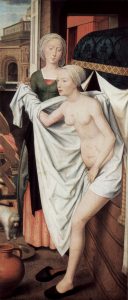
Hans Memling, The Toilet of Bathsheba After the Bath, ca. 1480, oil on canvas, 191 × 84 cm, Staatsgalerie, Stuttgart
In classical historiography, the gestures that would damage the material integrity of the picture have long been understood within the perspective of a history of iconoclasm, destruction, or artistic vandalism.[ref]Dario Gamboni, The Destruction of Art: Iconoclasm and Vandalism since the French Revolution (New Haven: Yale University Press, 1997).[/ref] Beyond this history, there exist, too, some gestures of admiration and creativity that affect the material integrity of the work (sometimes to the point of destroying it). What are those gestures? Can one do a history of them? What do they tell us about our relationship to art?
In Le détail: pour une histoire rapprochée de la peinture, Daniel Arasse has shown—in a completely counterintuitive way—that cutting up a picture, literally retailing it in parts [détailler], had been a tolerated (if not altogether classic) way of relating to an artwork. A number of “pictures” that have reached us have thus been the object of a “playful slicing of one’s gaze”: the current upper left part of Hans Memling’s The Toilet of Bathsheba After the Bath, ca. 1480 (Staatsgalerie, Stuttgart), which represents an architectural view, is a later modification (fig. 1). Originally, it included a figure of King David with a child.
Inscribing one’s name on an artwork is another practice attested to as early as the sixteenth century in Europe, which testifies to the admiration one has for the work. Such inscriptions have been the object of some major scholarly studies in museums and on the art market: these are marks having to do with collections and provenance that are used to certify authenticity, reconstruct the picture’s pedigree—and guarantee its economic and symbolic value. Yet they have not given rise to a more theoretical questioning: Why mark a work?
Numerous museums exhibit works that are stamped with wax, or branded with iron, by their owners. We are accustomed to seeing them on the backs, but sometimes, too, on the front of the picture, in the space of the representation itself.
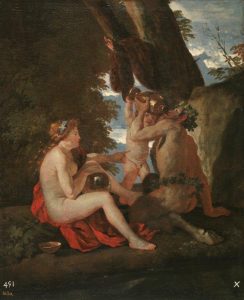
Nicolas Poussin, Bacchic Scene, 1626-1628, oil on canvas, 74 × 60 cm, Madrid, Prado National Museum
In Nicolas Poussin’s Bacchic Scene (fig. 2), one can make out two numbers at the lower left (which tell of the peregrinations of the picture in the royal Spanish collections) and a cross in white paint on the right (which calls to mind Philip V of Spain’s Cross of Burgundy).[ref]Maria Lopez-Fanjul, Diez del Corral, and José Juan Pérez Preciado, “Los numeros y marcs de coleccion en los cuadros del Museo del Prado,” Boletin del Museo del Prado, 23:41 (2005): 84-110.[/ref]
If one really wants to do this history, one may say that these marks affixed on the medium inscribe onto the work the series of its successive attachments, which have tied it to one or several individuals in the course of its social life.[ref]Thierry Bonnot, L’attachement aux choses (Paris: CNRS, 2014). From another perspective, refer to Charlotte Guichard, Graffitis. Inscrire son nom à Rome, XVe-XIXe siècles (Paris: Seuil, 2014).[/ref] Stamps and marks incorporate into the artwork a network of gestures and agents that partake of the artistic deed, the agency of the art, conferring upon it the thickness of its material and biographical history. In these prints and these names incorporated into the work’s very matter, the manufacture of artistic value is closely interwoven with the economic production of value, so much are these proper names, too, already caught within the networks of reputation and grandeur that certify to the value and authenticity of works. Thus, this trivial look at the picture allows one to restitute (to use the vocabulary of Bruno Latour) the series of successive instances of interestedness—whereas, in Kantian aesthetics, it is disinterestedness that is constitutive of beauty’s universal value.
The Dematerialization of the Picture
The reception of Kantian aesthetics in the early nineteenth century converges with two changes that affected, at the same moment, the worlds of art: the rise of the museum as institution and the triumph of an age of technical reproduction. While the museum was first thought of as a treasury, the unique, material collection of works to be preserved and transmitted, the conditions for the visibility of works became radically different from the conditions that prevailed in private collections, where the owner (or the keeper) might authorize or encourage visitors to approach the works and handle them.
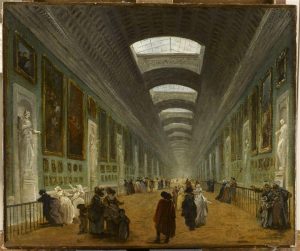
Hubert Robert, Projet d’aménagement de la Grande Galerie du Louvre, ca. 1789, oil on canvas, 46 × 55 cm, Paris, Louvre Museum
As early as the first plans that were developed on the eve of the French Revolution, the future Louvre was designed to have protective barriers (fig. 3). Such barriers impose a distance as well as a purely visual relationship with the pictures exhibited. Likewise, with the free opening to the public, surveillance increased. On August 1, 1796, increased monitoring in the Laoccoon room was requested to respond to the growing crowds. One dreaded the (bad) manners of a broader public, which one suspected lacked the decorum that had ruled during visits to private collections in Ancien Régime France. Thus were the works protected, set at a distance on a wall, and reduced to the status of images.
This exhibition arrangement goes hand in hand with another change. At the museum, pictures have lost the use value they quite often had in people’s homes. For, what is a picture, after all? “One calls easel pictures Medium-Sized Pictures that are set on chimney mantels, above doors or wainscoting panels, or on tapestries against walls.”[ref]“Tableau,” article in the Dictionnaire des arts et des sciences, 1694.[/ref] One should not be mistaken: a picture for the pure contemplative gaze is not the norm in the modern era. Painters also quite often executed over-the-door works, over-the-fireplace works, and panels to be inserted in the wainscoting.
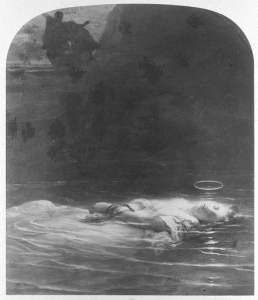
Robert Jefferson Bingham, La jeune martyre, tableau de Paul Delaroche in 1858, print on albumin paper from a glass negative, foam-backed on cardboard, 17.5 cm × 15.2 cm, Paris, Orsay Museum
This was the case for countless panels painted by François Boucher in the eighteenth century that were cut up again before entering into the museum, with a today classical rectangular, quadrangular, or oval format.
In parallel with the foregoing, the development of an age of technical reproduction (to use Walter Benjamin’s formula) also favored the picture’s loss of thingness. Along with lithographs, photographic reproductions of pictures were on the rise in people’s homes. In 1860, such images of artworks represented 28.5 percent of photographic sales in Paris, and the photographer Robert J. Bingham specialized in this field (fig. 4).[ref]Elizabeth Anne McCauley, Industrial Madness: Commercial Photography in Paris 1848-1871 (New Haven and London: Yale University Press, 1994), pp. 269-79 ; Laure Boyer, “Robert J. Bingham, photographe du monde de l’art sous le Second Empire,” Études photographiques, 12 (November 2002): http://etudesphotographiques.revues.org/320.[/ref] In Swann’s Way, Marcel Proust mentions several times the sudden irruption of such photographic art reproductions within the domestic sphere and the desperate attempts of his grandmother to offer him some beautiful old engravings, the ultimate strategy for preserving distinction when faced with the spread of the art image into the most common domestic settings. At the same time that it was losing its materiality, the picture was also losing its agency: Who would go to have one’s photo taken in front of a reproduction of a picture?
The Picture as Commodity
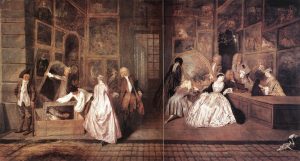
Jean-Antoine Watteau, The Shop Sign of Gersaint, 1720, oil on canvas, 166 × 306 cm, Berlin, Charlottenburg Palace
While the reflection we have thus sketched out about the picture’s thingness owes much to a relatively recent raising of consciousness among art historians, artists have never ceased to reflect on the materiality of their art. Such reflection indeed fits into a long tradition, that of the “instauration of the picture.” Victor Stoichita has thus brought to light this metapictorial tradition, active in Europe, which meditated on the status “of the picture as object and as image.” Such “self-aware images” themselves grounded the modern condition of art, as is testified to by Cornelius Norbertus Gijsberchts’s Trompe-l’œil: The Reverse of a Framed Painting (1670-1675), about which he writes: “The object of this painting is the painting as an object.” This reflective tradition, which thinks the picture as a problem,[ref]Victor Stoichita, L’instauration du tableau. Métapeinture à l’aube des temps modernes (Geneva: Droz, 1999), p.353-54, 364, and 367. The quotation appears in the English-language translation, The Self-Aware Image: An Insight into Early Modern Meta-Painting (New York : Cambridge University Press, 1997), p. 277.[/ref] continued well beyond the seventeenth century, though in different ways. For, in the painting of the Age of Enlightenment, it was also discovered that the picture is a commodity.
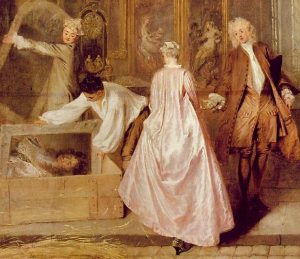
Jean-Antoine Watteau, The Shop Sign of Gersaint, 1720 (detail of the crate)
In The Shop Sign of Gersaint (fig. 5), Jean-Antoine Watteau offered an ambitious reflection on the picture’s entrance into the age of commodification and consumerism. The pictures on sale are likened to luxury goods and fashion items; the portrait of the king, which was at the time, as Louis Marin has shown, the most perfected form of representation, is demoted to the rank of a commodity, placed in a nailed-up crate marked in black: one can clearly see the inscription “IIIX,” reminiscent of the marking of crates and packages in the modern era (detail, fig. 6). The artist is sensitive to the emergence of a new, anonymous art market that is no longer structured by commissions and social relations and where the picture is considered a commodity—indeed, it is precisely against this trivial way of looking at pictures that art criticism, and then a certain kind of aesthetic approach, will inveigh. If one pursues the reflection of Caroline van Eck, for whom the Kantian aesthetic has served as an epistemological barrier against the fetishism of art, one can ask oneself whether this barrier has not also served as a rampart against the commodification of art.
Bibliography
ANDERSON, Christy. Anne Dunlop, and Pamela H. Smith. Eds. The Matter of Art: Materials, Practices, Cultural Logics, c. 1250-1750. Manchester: Manchester University Press, 2015.
ARASSE, Daniel. Le détail. Pour une histoire rapprochée de la peinture. Paris: Flammarion, 1992.
BONNOT, Thierry. L’attachement aux choses. Paris: CNRS, 2014.
CLASSEN, Constance. “Museum Manners: The Sensory Life of the Early Museum.” Journal of Social History, 40:4 (2007).
GAMBONI, Dario. The Destruction of Art: Iconoclasm and Vandalism since the French Revolution. New Haven: Yale University Press, 1997.
GUICHARD, Charlotte. Graffitis. Inscrire son nom à Rome, XVe-XIXe siècles. Paris: Seuil, 2014.
LATOUR, Bruno. Changer de société. Refaire de la sociologie. Paris: La Découverte, 2006.
LICHTENSTEIN, Jacqueline. Les raisons de l’art. Essai sur les théories de la peinture. Paris: Gallimard, 2014.
McCAULEY, Elizabeth Anne. Industrial Madness: Commercial Photography in Paris, 1848-1871. New Haven and London: Yale University Press, 1994.
STOICHITA, Victor. L’instauration du tableau. Métapeinture à l’aube des temps modernes. Geneva: Droz, 1999.
VAN ECK, Caroline. Art, Agency and Living Presence: From the Animated Image to the Excessive Object. Boston: De Gruyter, 2015.
A former student at the École Normale Supérieure, Charlotte Guichard is a research fellow at the French National Center of Scientific Research (CNRS, French Institute of Modern and Contemporary History, Paris). Specializing in the art of the Age of Enlightenment, her work bears in particular on the history of the art market and collections, intercultural exchanges in the arts, the value of art, and the dialogue between Art History and the Social Sciences. She is the author of Les amateurs d’art à Paris au XVIIIe siècle (Champ Vallon, 2008); Graffitis. Inscrire son nom à Rome, XVe-XIXe siècles (Seuil, 2014), written when she was a boarder at Villa Médicis. She is currently preparing the publication of her new book, La griffe du peintre. Essai sur la signature dans le tableau (1730-1820).
